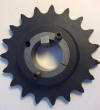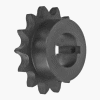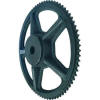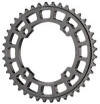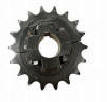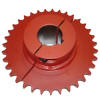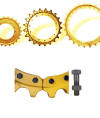| Videos | ||||
| Chain sprockets are sturdy wheels with teeth that lock onto a chain and move other parts that interlock with the chain. This allows for controlled rotational movement of larger equipment and machinery. Sprockets are an essential component in many power transmission systems and are used to transmit power and motion between two or more chains. | ||||
| Solid sprocket | ||||
| A solid sprocket is a sturdy wheel with teeth that lock onto a chain to transmit rotation or tension. As the sprocket spins, its teeth grab the chain, which moves other parts that interlock with the chain. This allows for controlled rotational movement of machinery and larger equipment. | ||||
|
||||
| Solid sprocket with spokes | ||||
| Sprockets can be cast with spokes or have a solid-type body. Sprockets are sturdy wheels with teeth that lock onto a chain and move other parts that interlock with the chain, allowing for controlled rotational movement of machinery and larger equipment. Sprockets with spokes are normally used to reduce mass. | ||||
|
||||
| Split sprocket | ||||
| A split sprocket is a sprocket that is made up of two or more separate equal sections, or "sprocket segments" or "sprocket halves". They are becoming more popular in industrial applications because they can be installed by hand and without disassembling other components. Split sprockets are also suitable for tight environments and are made in several pieces that are each a manageable size. | ||||
|
||||
| Idler sprocket | ||||
| An idler sprocket is a flat, hubless sprocket with a sealed bearing that allows it to rotate freely. Idler sprockets are used in conveyor belt systems, agriculture, and forestry. They are typically mounted in a fixed position on a fixed shaft or attached to a tensioner arm. Idler sprockets are used for the following reasons: | ||||
|
||||
| An idler sprocket is generally recommended for fixed centre drives. It should be positioned on the slack side as close to the larger sprocket as feasible. The idler sprocket should have a minimum of three teeth engaged and be a minimum of four links away from the nearest sprocket. | ||||
|
||||

TVET COLLEGE SUPPORT
CHAIN DRIVES
Types of Sprockets
